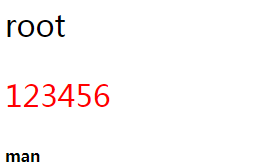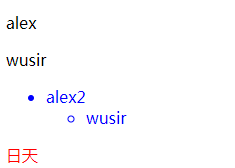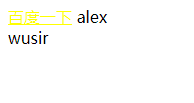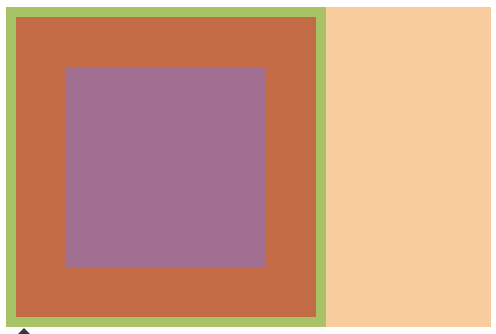CSS:
-
css-引入方式
-
css-选择器
高级选择器
属性选择器
伪类选择器
伪元素选择器
-
css-继承性和层叠性
层叠性权重相同处理
-
css-盒模型
padding(内边距)
border(边框)
margin(外边距)
-
css-标准文档流
块级元素和行内元素
css-浮动
一、css-引入方式
1.css介绍
现在的互联网前端分为三层:
HTML:超文本标记语言。从语义的角度描述页面结构;
CSS:层叠样式。从审美的角度负责页面样式;
JS:JavaScript。从交互的角度描述页面行为;
CSS:Cascading Style Sheet,层叠样式表。CSS的作用就是给HTML页面标签添加各种样式,定义网页的显示效果。简单一句话:CSS将网页内容和显示样式进行分离,提高了显示功能。
2.HTML的缺陷
不能适应多种设备;要求浏览器必须只能足够庞大;数据和显示没有分开;功能不够强大;
3.CSS优点
使数据和显示分开;降低网络流量;使整个网站视觉效果一致;是开发效率提高(耦合性降低)
比如说,有一个样式需要在一百个页面上显示,如果是html来实现,那要写一百遍,现在有了css,只要写一遍。现在,html只提供数据和一些控件,完全交给css提供各种各样的样式。
4.四种方式
4.1行内样式
<div> <p style="color: green">我是一个段落</p> </div>
4.2内接样式
<style type="text/css"> /*写我们的css代码*/ span{ color: yellow; } </style>
4.3外接样式-链接式
<head> <link rel="stylesheet" href="./index.css"> </head>
4.4外接样式-导入式
<style type="text/css"> @import url('./index.css'); </style>
二、css-选择器
1.基本选择器
1.1标签选择器
标签选择器可以选中所有的标签元素,比如div,ul,li ,p等等,不管标签藏的多深,都能选中,选中的是所有的,而不是某一个,所以说 "共性" 而不是 ”特性“

<!DOCTYPE html> <html lang="en"> <head> <meta charset="UTF-8"> <title>Title</title> <!--在样式里将所有p标签的内容字体全部加粗--> <style> p{ font-weight: bolder; } </style> </head> <body> <p>哈哈</p> <p>嘿嘿</p> <p>嘻嘻</p> <p>啦啦</p> <p>哼哼</p> </body> </html>
网页显示:

1.2 id选择器
#id值,表示选择的ID
同一个页面中id不能重复;任何的标签都可以设置id;
id命名规范和python变量命名一样;

<!DOCTYPE html> <html> <head> <meta charset="UTF-8"> <title>Title</title> <!--分别设置各id内的样式--> <style> #user{ font-size: 30px; } #pass{ color: red; } #gender{ font-weight: bolder; } </style> </head> <body> <div id="user"> root <p id="pass">123456</p> </div> <span id="gender">man</span> </body> </html>
网页显示:

1.3类选择器
所谓类:就是class . class与id非常相似 任何的标签都可以加类,但是类是可以重复,属于归类的概念。同一个标签中可以携带多个类,用空格隔开。
类的使用,能够决定前端工程师的css水平到底有多厉害,玩类,一定要有”公共类“的概念;

<!DOCTYPE html> <html> <head> <meta charset="UTF-8"> <title>Title</title> <!--分别设置各id内的样式--> <style> .lg{ font-size: 30px; } .lv{ color: green; } .un{ text-decoration: underline; } </style> </head> <body> <!-- 要求: 张鋆康1 30px green 张鋆康2 green text-decoration:underline; 张鋆康3 30px 下划线 --> <!-- 公共类 --> <p id="p1" class="lg lv">张鋆康1</p> <p id="p2" class="lv un">张鋆康2</p> <p id="p3" class="lg un">张鋆康3</p> </body> </html>
网页显示:

类小结:
不要去试图用一个类将所有的页面写完,这个标签要带多个类,共同设置样式;
每个类要尽可能的小,有公共的概念,能够让更多的标签使用;
到底使用id还是class?
尽量使用class,除非一些特殊情况下可以使用id;因为id一般用在js的,也就是说,js是通过id来获取标签的;
2.高级选择器
高级选择器又分为:后代选择器、子代选择器、并集选择器、交集选择器;
2.1后代选择器
使用空格表示后代选择器。故名思议,父元素的后代(包括儿子、孙子、重孙子)

<!DOCTYPE html> <html> <head> <meta charset="UTF-8"> <title>Document</title> <style> .father p{ color: red; } </style> </head> <body> <div class="father"> <p>alex</p> <ul> <li> <p class="wu">wusir</p> </li> </ul> </div> <p class="wu">日天</p> </body> </html>
网页显示:


<!DOCTYPE html> <html> <head> <meta charset="UTF-8"> <title>Document</title> <style> .father p{ color: red; } .father .wu{ color: green; } </style> </head> <body> <div class="father"> <p>alex</p> <ul> <li> <p class="wu">wusir</p> </li> </ul> </div> <p class="wu">日天</p> </body> </html>
网页显示:

这是怎么回事呢?如果遇到这种情况我们怎么去判断呢?下面会讲到标签的“优先级”
2.2子代选择器
使用>表示子代选择器,比如div>p,仅仅表示的是当前div元素选中的子代(不包含孙子)元素p

<!DOCTYPE html> <html> <head> <meta charset="UTF-8"> <title>Document</title> <style> .father>ul>li{ color: blue; } .container{ color: red; } </style> </head> <body> <div class="father"> <p>alex</p> <div class="content"> <p>wusir</p> </div> <ul> <li> alex2 <ul> <li>wusir</li> </ul> </li> </ul> </div> <div class="container"> <p>日天</p> </div> </body> </html>
网页显示:

有没有发现一个问题,为什么我们只是想改alex2,怎么连带wusir也更改了呢??,这是因为继承的问题,我们下文在说此问题。
2.3并集选择器(也称组合选择器)
多个选择器之间使用逗号隔开,表示选中的页面中的多个标签。一些共性的元素,可以使用并集选择器;

<!DOCTYPE html> <html> <head> <meta charset="UTF-8"> <title>Document</title> <style> body,div,p,a,span{ padding: 0; margin: 0; } </style> </head> <body> <div> alex </div> <p>alex2</p> <a href="#">日天</a> <span>wusir</span> </body> </html>
网页显示:

比如百度首页使用的就是并集选择器:

body,h1,h2,h3,h4,h5,h6,hr,p,blockquote,dl,dt,dd,ul,ol,li,pre,form,fieldset,legend,button,input,textarea,th,td {
margin: 0;
padding: 0
}
/*使用此并集选择器选中页面中所有的标签,页面布局的时候会使用*/
2.4交集选择器
使用.表示交集选择器。第一个标签必须是一个标签选择器,第二个标签必须是一个类选择器,比如:div.active

<!DOCTYPE html> <html> <head> <meta charset="UTF-8"> <title></title> <style> div{ color: red; } div.active{ color: green; } </style> </head> <body> <div class="active">alex</div> <div class="username">alex</div> </body> </html>
网页显示:

3.属性选择器
属性选择器,字面意思就是根据标签中的属性,选中当前的标签;

/*根据属性查找*/
/*[for]{
color: red;
}*/
/*找到for属性的等于username的元素 字体颜色设为红色*/
/*[for='username']{
color: yellow;
}*/
/*以....开头 ^*/
/*[for^='user']{
color: #008000;
}*/
/*以....结尾 $*/
/*[for$='vvip']{
color: red;
}*/
/*包含某元素的标签*/
/*[for*="vip"]{
color: #00BFFF;
}*/
/**/
/*指定单词的属性*/
label[for~='user1']{
color: red;
}
input[type='text']{
background: red;
}

<!DOCTYPE html> <html> <head> <meta charset="UTF-8"> <title></title> <style> form input[type='text']{ background-color: red; } form input[type='password']{ background-color: yellow; } form #user{ background-color: green; } </style> </head> <body> <form action=""> <input type="text" id="user"> <input type="password"> </form> </body> </html>
网页显示:

4.伪类选择器
伪类选择器一般会使用在超链接a标签中,使用a标签的伪类选择器,我们一定要遵循“爱恨准则” LoVe HAte

/*没有被访问的a标签的样式*/
.box ul li.item1 a:link{
color: #666;
}
/*访问过后的a标签的样式*/
.box ul li.item2 a:visited{
color: yellow;
}
/*鼠标悬停时a标签的样式*/
.box ul li.item3 a:hover{
color: green;
}
/*鼠标摁住的时候a标签的样式*/
.box ul li.item4 a:active{
color: yellowgreen;
}

/*选中第一个元素*/
div ul li:first-child{
font-size: 20px;
color: red;
}
/*选中最后一个元素*/
div ul li:last-child{
font-size: 20px;
color: yellow;
}
/*选中当前指定的元素 数值从1开始*/
div ul li:nth-child(3){
font-size: 30px;
color: purple;
}
/*n表示选中所有,这里面必须是n, 从0开始的 0的时候表示没有选中*/
div ul li:nth-child(n){
font-size: 40px;
color: red;
}
/*偶数*/
div ul li:nth-child(2n){
font-size: 50px;
color: gold;
}
/*奇数*/
div ul li:nth-child(2n-1){
font-size: 50px;
color: yellow;
}
/*隔几换色 隔行换色
隔4换色 就是5n+1,隔3换色就是4n+1
*/
div ul li:nth-child(5n+1){
font-size: 50px;
color: red;
}

<!DOCTYPE html> <html> <head> <meta charset="UTF-8"> <title></title> <style> /*爱恨准则 LoVe HAte*/ /*没有被访问的a标签的颜色*/ a:link{ color: green; } /*访问过后的a标签的颜色*/ a:visited{ color: yellow; } /*鼠标悬停的时候a标签的颜色*/ a:hover{ color: red; } /*鼠标点击时的颜色*/ a:active{ color: blue; } /*鼠标悬停时字体的变化,可以变颜色,可以变大小,可以加下划线等等*/ span:hover{ color: red; font-size: 24px; text-decoration: underline; } /*设置child类默认为隐藏属性,当鼠标停留在父类时则显示出子类child*/ .child{ display: none; } .father:hover .child{ color: red; display: block; } </style> </head> <body> <a href="#">百度一下</a> <span>alex</span> <div class="father"> wusir <p class="child">alex</p> </div> </body> </html>
网页显示:




5.伪元素选择器

/*设置第一个首字母的样式*/
p:first-letter{
color: red;
font-size: 30px;
}
/* 在....之前 添加内容 这个属性使用不是很频繁 了解 使用此伪元素选择器一定要结合content属性*/
p:before{
content:'alex';
}
/*在....之后 添加内容,使用非常频繁 通常与咱们后面要讲到布局 有很大的关联(清除浮动)*/
p:after{
content:'&';
color: red;
font-size: 40px;
}

<!DOCTYPE html> <html lang="en"> <head> <meta charset="UTF-8"> <title>Document</title> <style> p:first-letter{ color: red; font-size: 26px; } /*用伪元素 属性一定是content*/ /*伪元素选择器与后面的布局有很大关系*/ p:before{ content: '$' } p:after{ content: '.' } .box2{ /*需求:这个盒子一定是块级标签 span==>块 并且不再页面中占位置。未来与布局有很大关系 */ /*隐藏元素 不占位置*/ /*display: none;*/ display: block; /*display: none;*/ /*隐藏元素 占位置*/ visibility: hidden; height: 0; } </style> </head> <body> <p class="box"> <span>alex</span> </p> <span class="box2">alex</span> <div>wusir</div> </body> </html>
网页显示:


说明元素被隐藏了但是还占用着位置呢,444*0
三、css-继承性和层叠性
css有两大特性:继承性和层叠性
1.继承性
面向对象语言都会存在继承的概念,在面向对象语言中,继承的特点:继承了父类的属性和方法。那么我们现在主要研究css,css就是在设置属性的。不会牵扯到方法的层面;
继承:给父级设置一些属性,子级继承了父级的该属性,这就是我们的css中的继承;
记住:有一些属性是可以继承下来 : color 、 font-*、 text-*、line-* 。主要是文本级的标签元素;
但是像一些盒子元素属性,定位的元素(浮动,绝对定位,固定定位)不能继承;

<!DOCTYPE html> <html lang="en"> <head> <meta charset="UTF-8"> <title>Document</title> <style> .box{ color: red; } .box a{ color: yellow; } .box p{ color: green; font-size: 30px; line-height: 30px; background-color: red; text-align: right; } span{ background-color: transparent; } </style> </head> <body> <div class="box"> 日天 <a href="#">百度</a> <p> wusir <span>alex</span> </p> </div> </body> </html>
网页显示:


2.层叠性
层叠性: 权重的标签覆盖掉了权重小的标签,说白了 ,就是被干掉了;
权重: 谁的权重大,浏览器就会显示谁的属性;
谁的权重大? 非常简单就是小学的数数。
顺序:id > class > 标签
先来看一个简单的例子:

<!DOCTYPE html> <html lang="en"> <head> <meta charset="UTF-8"> <title>Document</title> <style> /*css层叠性 权重 谁的权重大就会显示谁的样式*/ /*如何看权重 数数选择器 id class 标签*/ /*id class 标签*/ /*1 0 0*/ #box{ color: yellow; } /*0 1 0*/ .box{ color: green; } /*0 0 1*/ div{ color: red; } /*优先级: id > 类 > 标签*/ </style> </head> <body> <div class="box" id="box">猜猜我是什么颜色</div> </body> </html>
网页显示:

是不是感觉明白了?在来点有难度的

<!DOCTYPE html> <html lang="en"> <head> <meta charset="UTF-8"> <title> </title> <style> /*1 3 0 */ #father1 .box2 #father3 p{ color: yellow; } /*0 4 0*/ /*.box1 .box2 .box3 .box4{ color: red; }*/ /*2 1 1*/ #father1 #father2 .box3 p{ color: green; } </style> </head> <body> <div class="box1" id="father1"> <ul class="box2" id="father2"> <li class="box3" id="father3"> <p class="box4" id="child">猜猜我的颜色</p> </li> </ul> </div> </body> </html>
网页显示:

是不是更加明白了,再继续深入一下;

<!DOCTYPE html> <html lang="en"> <head> <meta charset="UTF-8"> <title> </title> <style> /*继承来的属性 它的权重为0,跟选中的标签没有可比性*/ #father1 #father2 #father3{ color: red; } #father1 .box2 .box3 p{ color: green; } </style> </head> <body> <div class="box1" id="father1"> <ul class="box2" id="father2"> <li class="box3" id="father3"> <p class="box4" id="child">猜猜我的颜色</p> </li> </ul> </div> </body> </html>
网页显示:

这回感觉怎么样?有没有明白这其中的道理?接着来看例子

<!DOCTYPE html> <html lang="en"> <head> <meta charset="UTF-8"> <title> </title> <style> /*继承来的属性 权重为0*/ /*如果是继承来的熟悉,就近原则,谁更深入谁厉害*/ #father1 .box2{ color: red; } .box1{ color: blue; } </style> </head> <body> <div class="box1" id="father1"> <ul class="box2" id="father2"> <li class="box3" id="father3"> <p class="box4" id="child">猜猜我的颜色</p> </li> </ul> </div> </body> </html>
网页显示:

最后在来看看一个例子;

<!DOCTYPE html> <html lang="en"> <head> <meta charset="UTF-8"> <title> </title> <style> /*继承来的属性 权重为0*/ /*都是继承来的 ,都一样深*/ #father1 #father2 .box3{ color: blue; } #father1 .box2 .box3{ color: green; } </style> </head> <body> <div class="box1" id="father1"> <ul class="box2" id="father2"> <li class="box3" id="father3"> <p class="box4" id="child">猜猜我的颜色</p> </li> </ul> </div> </body> </html>
网页显示:

层叠性小结:
a.首先看一下我们要修改的标签有没有在style样式里被选中,如果被选中,则此标签样式权重最大;(本身最大)
b.如果要修改的标签没有在style样式里则表示要修改的标签要继承他的父类了,这时就开始比父类,谁里要修改的标签越近谁的权重越大;(就近原则)
c.如果在style里出现了父类里要修改的标签一样进,那么开始比这两个父类的权重(id、class、标签),谁权重大谁能遗传给要修改的标签;(权重比较)
d.如果此时要修改的标签的两个父类权重,举例都是一样的,那么就按先来后到(从上到下)来定了,最后一个胜;(先来后到)
注意:
!important 的使用;!important:设置权重为无限大 ;!important 不影响继承来的权重,只影响选中的元素。不要随便使用!important,因为使用它会影响页面的布局。
四、盒模型
1.盒模型说明:
在CSS中,"box model"这一术语是用来设计和布局时使用,然后在网页中基本上都会显示一些方方正正的盒子。我们称为这种盒子叫盒模型。
盒模型有两种:标准模型和IE模型。我们在这里重点讲标准模型。
2.盒模型示意图

3.盒模型的属性
width:内容的宽度;
height: 内容的高度;
padding:内边距,边框到内容的距离;
border: 边框,就是指的盒子的宽度;
margin:外边距,盒子边框到附近最近盒子的距离;
练习:做一个320*320的盒子

<!DOCTYPE html> <html lang="en"> <head> <meta charset="UTF-8"> <title>Document</title> <style> .box{ width: 200px; height: 200px; color:blue; background-color: red; padding: 50px; border: 10px solid green; /*margin-left: 50px;*/ } </style> </head> <body> <!-- width:内容的宽度 height:内容的高度 padding:内边距 border:边框 margin:外边距 --> <div class="box"></div> </body> </html>
网页显示:

4.盒模型的计算
如果一个盒子设置了padding,border,width,height,margin(咱们先不要设置margin,margin有坑,后面课程会讲解)
盒子的真实宽度=width+2*padding+2*border
盒子的真实宽度=height+2*padding+2*border
